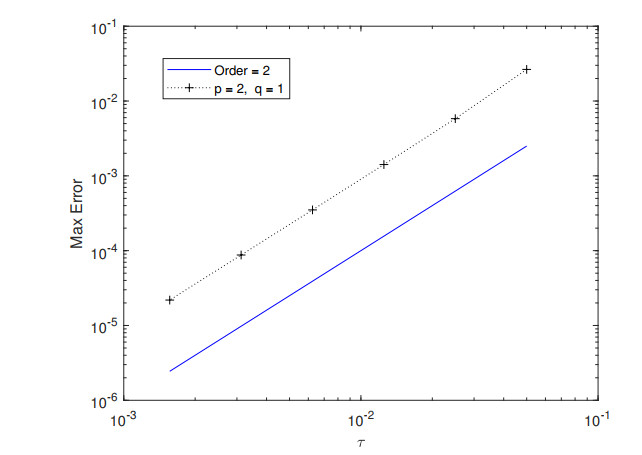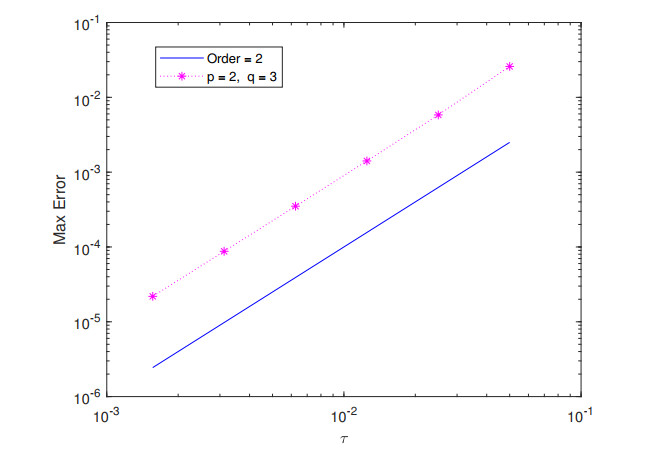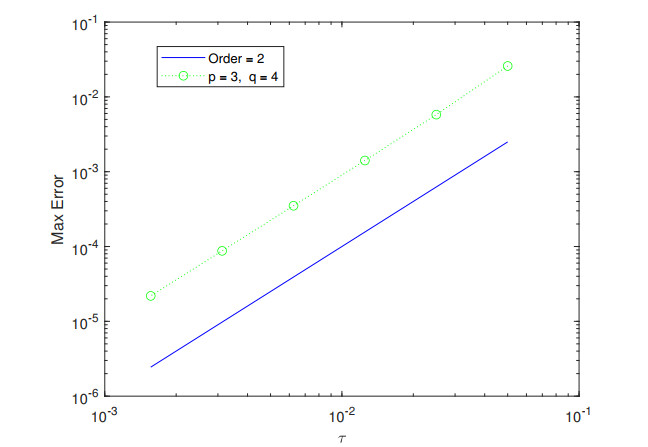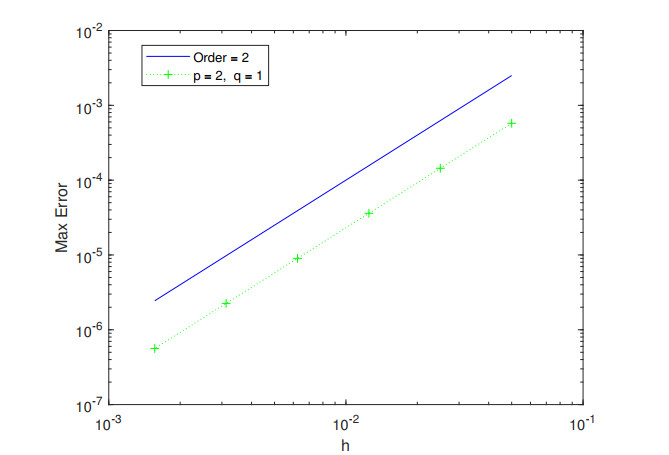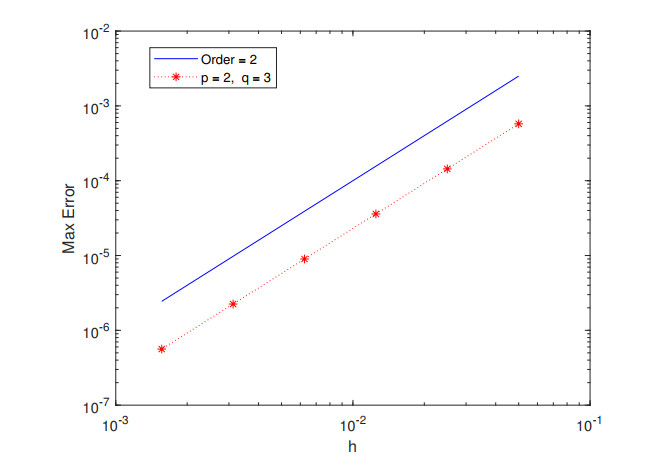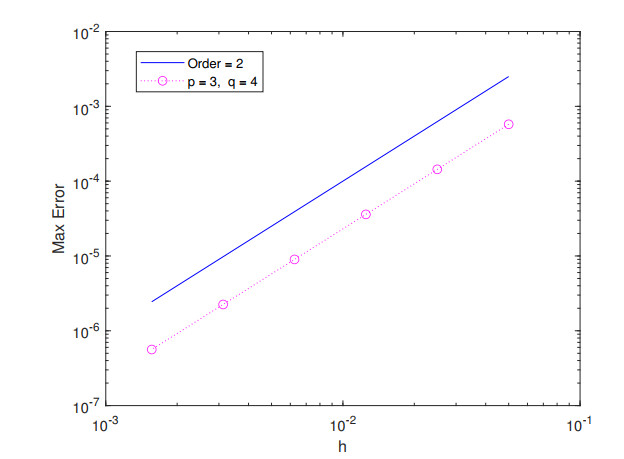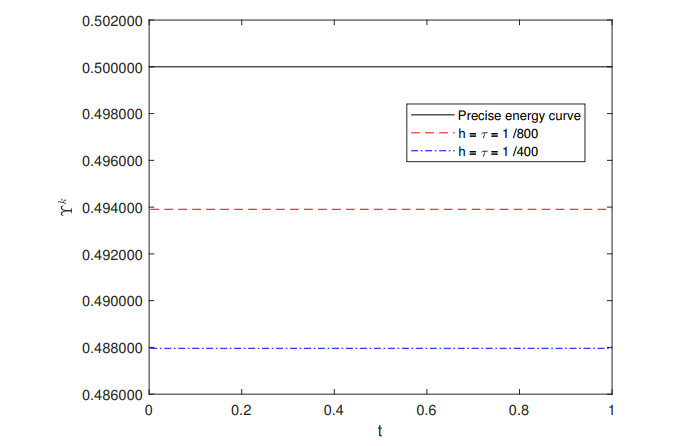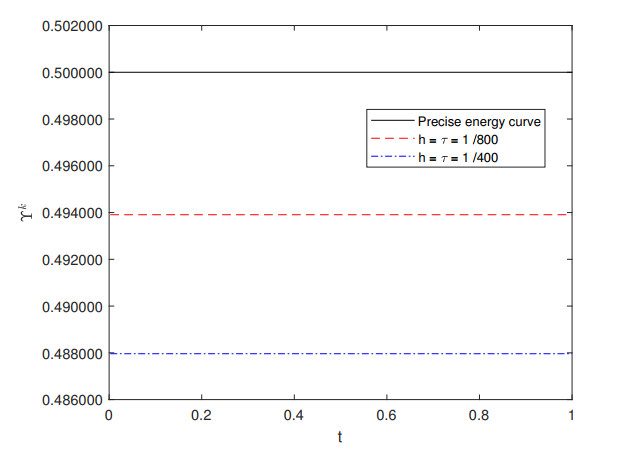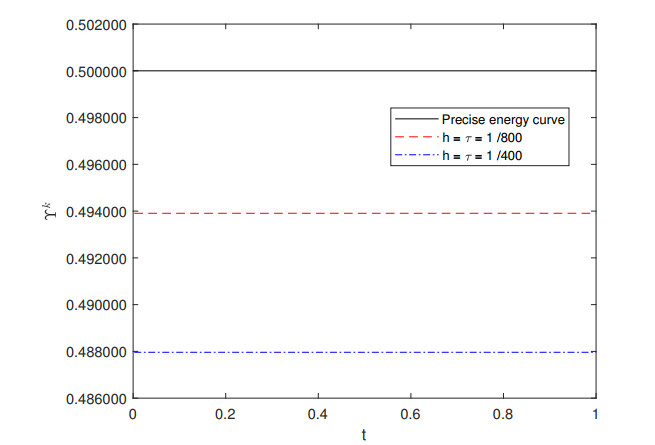1.
Introduction
In this paper, we shall present a incisive analysis of a finite difference method for solving the following supergeneralized viscous Burgers' equation in the domain [0,L]×[0,T]:
here L and T are positive constants, Ψ(x) that satisfies Ψ(0)=Ψ(L)=0 is smooth on [0,L], p≥1 and q≥0 are two positive integers, and positive constant ν denotes the dynamic viscosity coefficient.
In the last few decades, Burgers' equation for the case of supergeneralized viscous Burgers' equation with p=1 and q=0 has attracted much attention from researchers. It is caused by numerous effective applications of Burgers' equation to many fields of science and engineering like shock wave theory, cosmology, gas dynamics, quantum field and traffic flow, see e.g., [2,3,4,5,6]. The supergeneralized viscous Burgers' equation is a typical evolution equation, and recently a series of numerical methods have been developed to solve it, e.g., finite difference method [7,8,9,10,11], finite volume method [12,13,14], ADI method [15,16,17,18], collocation method [19,20], two-grid method [21,22] and extrapolation method [23]. Meanwhile, as the other simplified form of supergeneralized viscous Burgers' equation with p≥1 and q=0, the generalized Burgers' equation also plays an important role in applied mathematics and engineering, see e.g., [24,25,26,27]. Recently, Wang et al. [28] established two conservative fourth-order compact schemes for Burgers' equation. Zhang et al. [29,30] derived various efficient difference schemes for Burgers' type equations. Gao et al. [31] proposed a bounded high-order upwind scheme in the normalized-variable formulation for the modified Burgers' equations. Guo et al. [32] proposed a BDF3 finite difference scheme for the generalized viscous Burgers' equation. Hu et al. [33] considered an implicit difference scheme to study the local conservation properties for Burgers' equation. Pany et al. [34] investigated an H1-Galerkin mixed finite element method to approximate the solution of the Burgers' equation. In addition, Jiwari et al. [35] studied a numerical scheme which is a composition of forward finite difference, quasilinearization process and uniform Haar wavelets for solving Burgers' equation. Wang et al. [36] used the weak Galerkin finite element method to study a class of time fractional generalized Burgers' equation. Wang et al. [37,38,39] presented an implicit robust difference method to solve the modified Burgers equation on graded meshes. Zhang et al. [40] provided a fourth-order compact difference scheme for time-fractional Burgers' equation. Zhang et al. [41] considered a conservative decoupled difference scheme for the rotation-two-component Camassa-Holm system. Sun et al. [42] obtained nonlinear discrete scheme for generalized Burgers' equation with the help of meshless method. Zhang et al. [1] constructed various difference schemes for generalized Burgers' equation only with one positive parameter p≥1.
The previous works are mainly concerned with the simple case of the parameter p=1 for problem (1.1)–(1.3). Our scheme can extended the results in the previous work [1] with a positive integer p≥1. In this paper, the main contributions are as follows:
● We construct the discretization of the nonlinear term by a second-order operator in supergeneralized viscous Burgers' equation and provide complete theoretical analysis on the proposed scheme, including conservation, existence, uniqueness and convergence.
● We prove L2-norm and L∞-norm convergence in pointwise sense by the cut-off function method, which doesn't have any step ratio restrictions. The L2-norm and L∞-norm convergence are proved with separate and different ways, which is different from previous work in [1].
The rest of the paper is arranged as follows. We introduce some useful notations for discretization and construct our proposed scheme in Section 2. In Section 3, we present certain conclusions about conservative invariants and boundedness of the suggested numerical scheme, and we provide the proof of unique solvability and convergence. The numerical test in Section 4 is given to demonstrate the reliability of our analysis. A brief conclusion is followed in Section 5.
2.
Derivation of the three-level difference scheme
Firstly, for any integer s, we denote set Ns={i|1≤i≤s,i∈Z} and N0s={i|0≤i≤s,i∈Z}. For two positive integers ˜m and ˜n, define the spatial step h=L˜m, and the temporal step τ=T˜n. Denotexi=ih,i∈N0˜m; tk=kτ,k∈N0˜n. We introduce the mesh ˜ωLT=˜ωLטωT, where ˜ωL={xi|i∈N0˜m}, and ˜ωT={tk|k∈N0˜n}. Denote xi+12=12(xi+xi+1),i∈N0˜m−1 and tk+12=12(tk+tk+1),k∈N0˜n−1.
Let Jh={j|j=(j0,j1,⋯,j˜m)} and ∘Jh={j|j∈Jh,j0=j˜m=0} be the spaces of grid functions on ˜ωL. For d,j∈Jh, introducing the following notations:
Lemma 2.1. [28] Let j∈Jh and r∈∘Jh, then
Lemma 2.2. [28] Set j∈∘Jh, then
Lemma 2.3. Suppose that U=(U0,U1,…,U˜m), u=(u0,u1,…,u˜m)∈Jh and g(u) is a second-order smooth function. Denote e=(e0,e1,…,e˜m) and ei=Ui−ui, i∈N0˜m. Then there are ρ∈(0,1) and ζi∈(yi,ri) such that
where
Proof. Using the mean value theorem, one has
Again, applying the mean value theorem, we have
The proof is finished.
In order to construct a three-level conservative numerical scheme for supergeneralized viscous Burgers' equation (1.1)–(1.3), we first turn problem (1.1) into an equivalent form as follows:
where Cmq is the binomial coefficient, 0≤m≤q.
We denote Uki=u(xi,tk), and let uki denote the nodal approximation to the exact solution computed at the mesh point (xi,tk).
Considering (2.2) at the point (xi,tk), i∈N˜m−1, k∈N˜n−1, one gets
By Taylor expansion, one gets
where c1 is a positive constant.
We consider (1.1) at the point (xi,t0), i∈N˜m−1, noticing (1.2), and one gets
Denote
Considering (2.2) at the point (xi,t12), i∈N˜m−1, one gets
and
Noticing (1.2) and (1.3), we get
Omitting the small terms Pki in (2.3) and P0i in (2.7), and replacing Uki by uki, and W(m)ki by w(m)ki, i∈N˜m−1, k∈N˜n−1, respectively. Thus, we can obtain the three-level difference approximation for (1.1)–(1.3) as follows
Noticing that substituting (2.12) into (2.10), the three-level difference scheme only contains one variable uki.
3.
The numerical analysis of three-level difference scheme
We now begin to consider the energy conservation and boundedness of solution of the three-level numerical scheme (2.10)–(2.14).
Theorem 3.1. Suppose that {uki,w(m)ki|i∈N0˜m,k∈N0˜n} is the solution of (2.10)–(2.14), we get
where
Proof. 1) Taking the inner product of (2.11) with u12, one obtains
Since u12∈∘Jh, by Lemmas 2.1 and 2.2, one gets
Thus,
Namely,
2) Taking the inner product of (2.10) with uˉk, one gets
Since uˉk∈∘Jh, by Lemmas 2.1 and 2.2, we have
Thus,
Above equality can be rewritten as
Thus,
Corollary 3.2. Let {uki,w(m)ki|i∈N0˜m,k∈N0˜n} represent the solution of (2.10)–(2.14). Then one has
Proof. According to Theorem 3.1,
Thus,
Corollary 3.3. Let {uki,w(m)ki|i∈N0˜m,k∈N0˜n} represent the solution of (2.10)–(2.14). Then the computed solution uki can satisfy
Proof. From (3.4) and (3.5) in Theorem 3.1, we can get Corollary 3.3 directly. □
Furthermore, we will carry out the proof of existence and uniqueness of the solution of (2.10)–(2.14).
Theorem 3.4. The solution of (2.10)–(2.14) exists and it is unique.
Proof. According to (2.13) and (2.14), u0 has been determined uniquely. From (2.11) and (2.14), establishing a linear system with respect to u1, and considering the corresponding homogeneous system
Taking the inner product of (3.6) with u1, one has
By Lemmas 2.1 and 2.2, one gets
Therefore,
It is easy to obtain
It implies that (2.11) and (2.14) determine u1 uniquely.
Assume that uk and uk−1 have been known. By (2.10), (2.12) and (2.14), we get the following linear homogeneous system of equations with respect to uk+1:
Taking the inner product of (3.8) with uk+1, one has
By Lemmas 2.1 and 2.2, one gets
Therefore,
It is easy to obtain
Consequently, it implies that uk+1 solved by (2.10), (2.12) and (2.14) is unique.
Based on mathematical induction, (2.10)–(2.14) is uniquely solvable, and this completes the proof. □
In order to establish the convergence of (2.10)–(2.14), we will introduce the cut-off function method next.
Denote
Define a group of second-order smooth functions
where 0≤m≤q.
Denote
Based on the cut-off function method, we construct a new difference scheme as follows:
For the above difference scheme, it is conservative.
Theorem 3.5. Suppose that {uki,w(m)ki|i∈N0˜m,k∈N0˜n} represents the solution of (3.11)–(3.15), we get
where
Proof. The proof of (3.16) and (3.17) is similar to the proof of Theorem 3.1. □
Now we prove the L2-norm and L∞-norm convergence of (3.11)–(3.15).
Theorem 3.6. Assume that {uki,w(m)ki|i∈N0˜m,k∈N0˜n} is the solution of (3.11)–(3.15) and {Uki,W(m)ki|i∈N0˜m,k∈N0˜n} is the solution of (1.1)–(1.3), there exists a positive constant c2 such that
Proof. Define
Since (3.10), we get
Subtracting (3.11)–(3.15) from (2.3), (2.7) and (2.9) follows
When k=0, from (3.22) and (3.23), we get
Taking the inner product of (3.19) with e12, one gets
By Lemmas 2.1 and 2.2, we obtain
Substituting (3.26)–(3.28) into (3.25), we have
Thus,
When τ2≤13, noticing (2.8), one gets
or
By (3.10) and Lagrange mean value theorem, one gets
Taking the inner product of (3.20) with eˉk, one gets
Using Lemma 2.2, one obtains
Substituting (3.33) and (3.34) into (3.32), above equality (3.32) becomes
where a0=max0≤m≤qCmq.
Noticing that
Thus, by Lemma 2.1, we have
Noticing (3.30), (3.31) and (3.10), we have
Substituting (3.37) into (3.35), (3.35) yields
Combining (2.4), above equality (3.38) becomes
where c3=a0(1+q)˜c1ˆc12(p+2)+a20(1+q)2M2ˆc214(p+2)2ν and c4=a0(1+q)˜c1ˆc14(p+2)+14 are two positive constants.
Rearranging (3.39) to yield
For k∈N˜n−1, when 4c4τ≤13, (3.40) yields
Therefore,
According to Gronwall's inequality, we obtain
Noticing (3.24) and (3.29), one gets
where c2=e6(c3+2c4)T⋅[Lc21+Lc212(c3+2c4)]12.
Namely,
Theorem 3.7. Assume that {uki,w(m)ki|i∈N0˜m,k∈N0˜n} is the solution of (3.11)–(3.15) and {Uki,W(m)ki|i∈N0˜m,k∈N0˜n} is the solution of (1.1)–(1.3), there exists positive constants c7 and c8 such that
Proof. We will use the mathematical induction to prove the result. When k=0, from (3.22) and (3.23), we get
Therefore, the conclusion is valid for k=0.
1) Taking the inner product of (3.19) with δte12, one gets
Noticing that
then (3.46) becomes
Using Lemmas 2.1 and 2.2, we have
From (2.8), we get
When τ≤2ν, one gets
or
2) Taking the inner product of (3.20) with Δtek, one gets
Suppose (3.43) and (3.44) hold for 0≤k≤s (1≤s≤˜n−1).
From (3.10) and Lemma 2.2, one gets
When c7(τ2+h2)≤1, one gets
Using Lemma 2.2, above equality (3.50) becomes
Noticing that
By Lagrange mean value theorem and the Lemma 2.3, we have
Thus, combining (3.54) and (3.55) yields
Using Lemma 2.2, combining (3.51), (3.52) and (3.56), it is easy to get
where c9=(Lˆc1˜c1+12Lˆc1˜c1+12√6L2ˆc2˜c21) and c10=2ˆc0+12√Lˆc1(√L˜c1+1).
Thus, (3.53) becomes
where a0=max0≤m≤qCmq.
Noticing (2.4), (3.58) becomes
where c5=a20(q+1)2c29(p+2)2 and c6=a20(q+1)2c210(p+2)2 are two positive constants.
For 1≤k≤s, rearranging (3.59) to yield
When 2c6τν≤13, (3.60) yields
Therefore,
According to Gronwall's inequality, (3.61) yields
Noticing (3.45) and (3.49), one gets
where c7=e3c5+3c6νT⋅[Lc21+Lc212(c5+c6)]12.
Namely,
Consequently, (3.43) holds for k=s+1.
From Lemma 2.2, it is easy to get
Corollary 3.8. Let {uki,w(m)ki|i∈N0˜m,k∈N0˜n} be the solution of (3.11)–(3.15). When c7(τ2+h2)≤1, there exists two constants c11 and c12 such that
Proof. When c7(τ2+h2)≤1, one has
By Lemma 2.2, we get ‖uk‖∞≤√L2c10≡c12.
This means the solution of (3.11)–(3.15) is bounded. □
In the end, for the proposed scheme (2.10)–(2.14), we can obtain the following convergence.
Corollary 3.9. Let {uki,w(m)ki|i∈N0˜m,k∈N0˜n} be the solution of (2.10)–(2.14) and {Uki,W(m)ki|i∈N0˜m,k∈N0˜n} be the solution of (1.1)–(1.3). When c8(τ2+h2)≤1, one has
where c13 is a constant.
Proof. Let {ˆuki|i∈N0˜m,k∈N0˜n} be the solution of (3.11)–(3.15). When c8(τ2+h2)≤1, one has
Thus, gm(ˆuki)=(ˆuki)p+m.
This means the difference scheme (2.10)–(2.14) is equivalent to (3.11)–(3.15). According to Theorems 3.6 and 3.7, we finish the proof of Corollary 3.9. □
4.
Numerical test
A numerical example is given to verify theoretical conclusions of the three-level difference scheme for supergeneralized viscous Burgers' equation.
Example 4.1. We consider (1.1)–(1.3) with T=L=1, ν=1, Ψ(x)=sin(πx), and p, q take some different integer values, respectively.
To describe the numerical errors in L∞-norm for the computed solution and corresponding convergence orders, we denote
and
where h and τ are sufficiently small.
Table 1 lists the temporal convergence orders with h=164. We compute the spatial convergence orders with τ=164 in Table 2. Table 3 presents the temporal and spatial errors and convergence orders with τ=h. The corresponding error and convergence orders are presented in Figures 1–6. The results demonstrate (2.10)–(2.14) is convergent with the convergence order of two both in space and in time.
In Figures 7–9, we compute Υk in Theorem 3.1 to verify the conservativity of the difference scheme (2.10)–(2.14). The results demonstrate that difference scheme (2.10)–(2.14) is conservative.
5.
Conclusions
In this paper, a three-level linearized conservative scheme approximating supergeneralized viscous Burgers' equation is studied. We construct the discretization of the nonlinear term by a second-order operator in supergeneralized viscous Burgers' equation and prove the three-level scheme is uniquely solvable based on the mathematical induction. At last, the L2-norm and L∞-norm convergence are proved with separate and different ways.
Use of AI tools declaration
The authors declare that they have not used Artificial Intelligence (AI) tools in the creation of this article.
Conflicts of interest
The authors declare no conflict of interest.









 DownLoad:
DownLoad:
